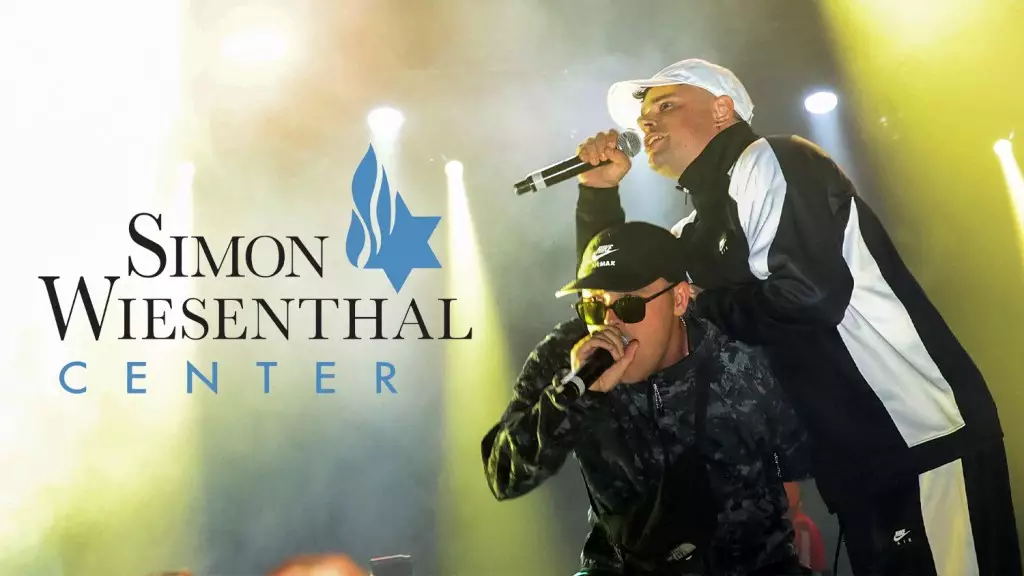The intersection of politics and music has always been a double-edged sword, capable of sparking both solidarity and division. This delicate balance was strikingly demonstrated during the recent Coachella festival, where the Irish hip-hop trio Kneecap took a provocative stance against Israel amid the ongoing violence in Gaza. Their performance quickly escalated tensions, earning them rebuke from several fronts, including the influential Simon Wiesenthal Center. This backlash illuminates how music, a medium traditionally celebrated for its unifying potential, can also serve to amplify animosity and division.
The Wiesenthal Center’s condemnation highlights an essential point: music should aim to cultivate understanding and compassion, rather than exacerbate conflicts. CEO Jim Berk articulated this sentiment eloquently when he stated that festivals like Coachella provide a platform ripe for connection, rather than hostility. Reflecting on his words, one must wonder if the aggrandizing rhetoric employed by groups like Kneecap enhances dialogue or simply devolves it into confrontational chants and polarizing imagery.
A Call for Deeper Dialogue
The confrontation at Coachella also raises critical questions about the responsibility of artists in politically charged environments. While many performers have historically used their platform to voice dissent—often to great effect—Kneecap’s explicit anti-Israel messages, such as “F*ck Israel” and accusations of genocide, lacked nuance. Music should challenge injustices; however, it should also foster deeper engagement and understanding of complex issues. Sharing one-dimensional narratives often hampers productive discourse, leaving truth and dialogue by the wayside.
The invitation extended by Berk for Kneecap to visit the Wiesenthal Center serves as a necessary reminder of how crucial it is for artists to grapple with the broader implications of their statements. Just as a song can incite movements and unify crowds, it can also deepen divisions and entrench animosity if it does not acknowledge the multifaceted nature of conflict. Engaging in discussions that include varying perspectives is vital for artists who wish to encourage social change without inadvertently contributing to the hatred and intolerance they claim to oppose.
Compassion vs. Provocation
Musicians, especially those with large audiences, wield significant power. When Kneecap chose to broadcast their anti-Israel sentiment boldly at such a prestigious venue, they were undoubtedly aware of the various reactions it would engender. While dissent is important, one must question the effectiveness of inflammatory slogans in creating meaningful dialogue. Does simply shouting one’s belief cultivate understanding, or does it create personal walls that leave no space for conversation?
Moreover, the festival atmosphere, meant for joy and celebration, contrasts sharply with the bleak realities being protested. This dissonance can create a sense of disconnection in the audience, transforming a time for unity into a moment of discord. Artists need to consider how their messages resonate within the collective experience of their audience. It’s a delicate balance, and many renowned musicians navigate this with care, crafting lyrics that challenge the status quo while simultaneously inviting listeners to consider alternative narratives.
The Broader Context of Conflict
The backdrop against which Kneecap performed cannot be overlooked. The recent escalation of violence, marked by the tragic events of October 7, 2023, dramatically changes the context of their claims. While articulating the experiences of the Palestinian people is crucial, failing to acknowledge the broader conflict, including the suffering and loss of innocent individuals on all sides, remains a glaring omission. Peaceful resolution requires an understanding of the narrative from multiple standpoints, an effort that seems increasingly rare in today’s divisive discourse.
A nuanced conversation regarding human rights, state violence, and international responsibility must replace blanket statements that isolate complex realities into “us vs. them” binaries. The challenge lies in fostering a space for dialogue that provides a platform for empathy rather than anger—a task that both artists and their audiences must embrace collectively.
Ultimately, Kneecap’s outburst at Coachella and the subsequent responses reflect a broader trend in modern activism. Art can be a potent vehicle for change, but that power comes with moral responsibility. Open and compassionate dialogue is the only way to ensure that the voices of the oppressed are heard without drowning others in the chaos of extremism. Engaging with sensitivity and a willingness to understand is required in an era where the stakes have never been higher for both artists and their audiences.

